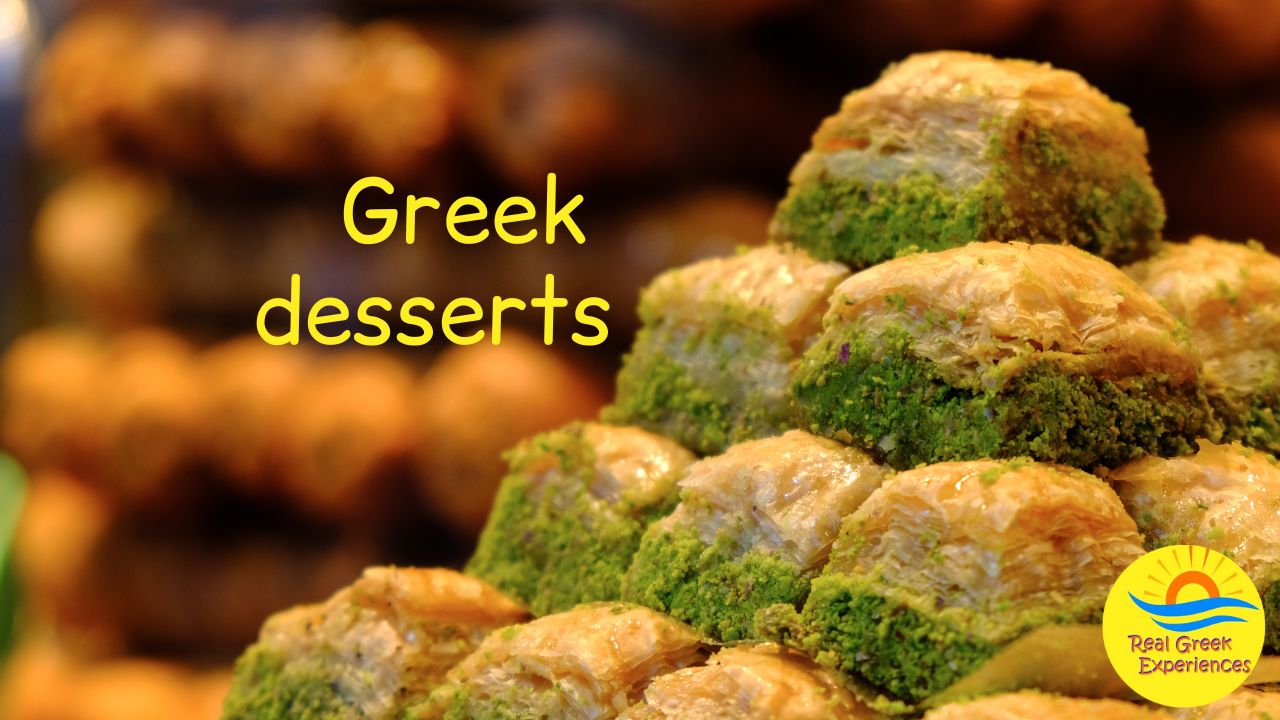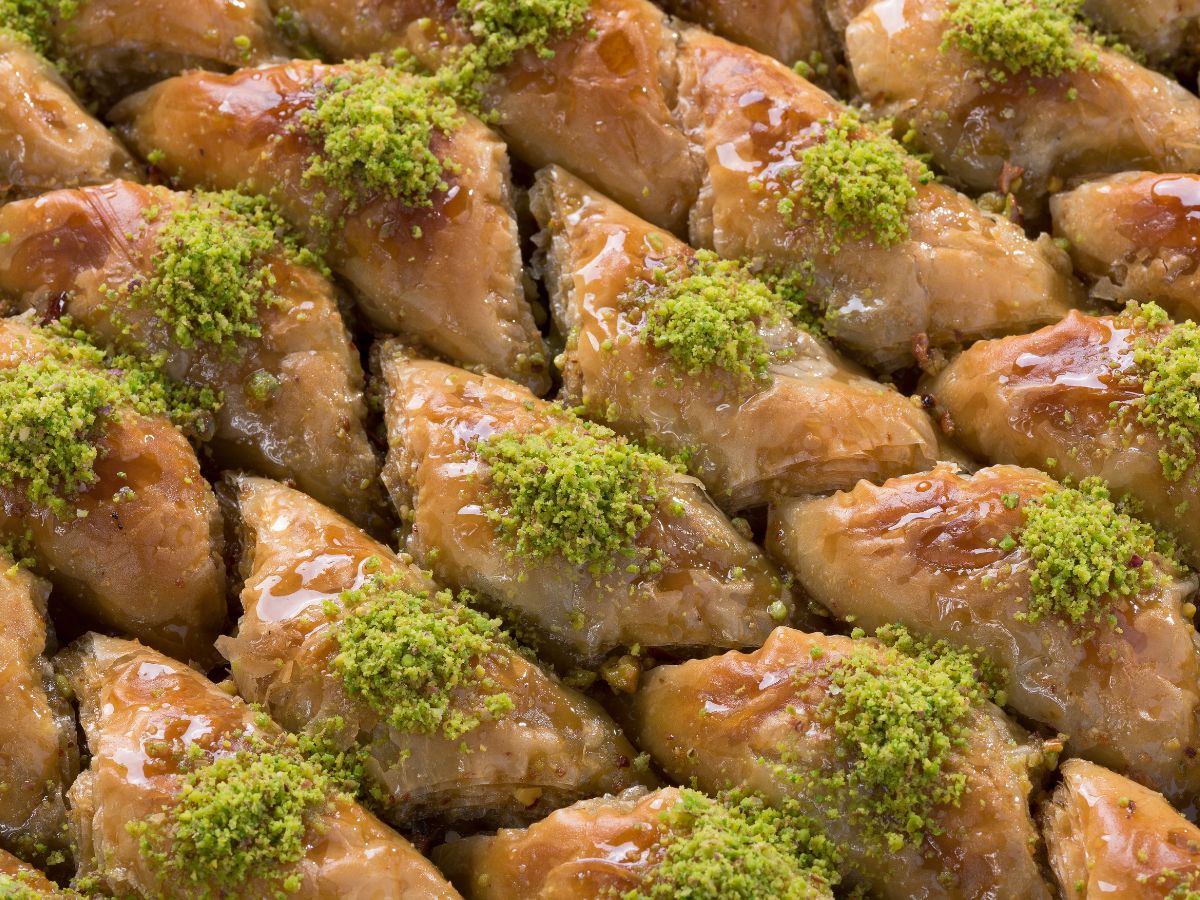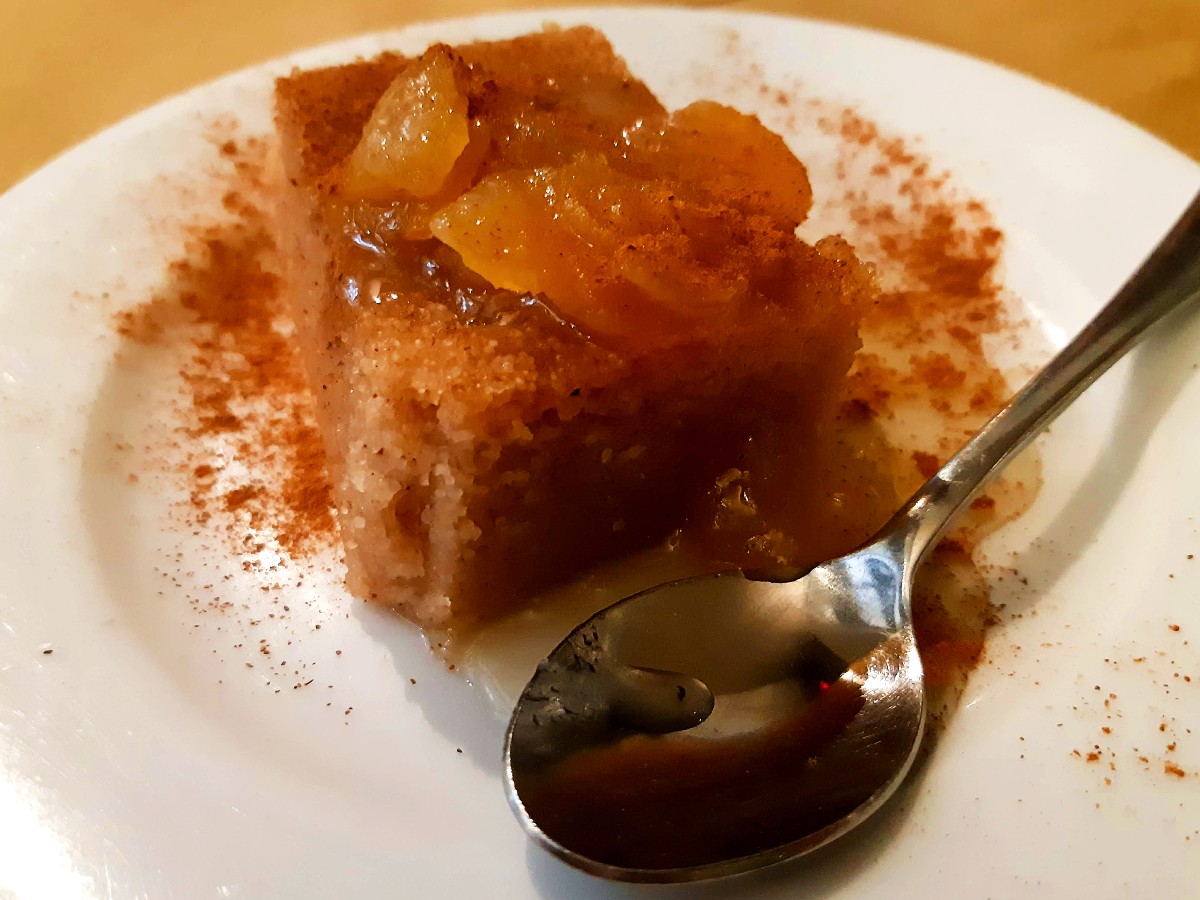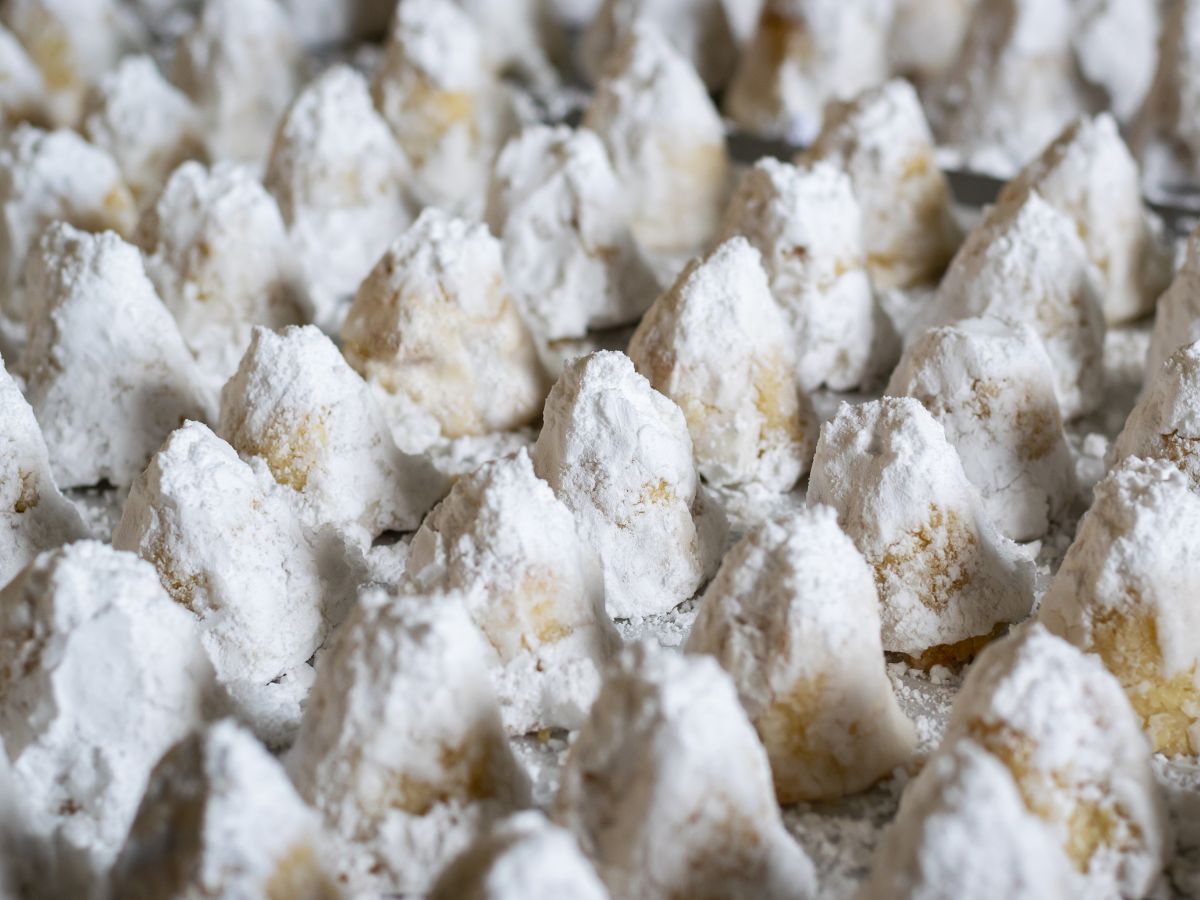When you visit Greece, you will want to taste some Greek desserts and traditional sweets! Here is a guide to some of the best Greek desserts that you need to try.

Famous Greek sweets and desserts
Greece is famous for its rich culinary history and fantastic food. Visitors love tasting the amazing Greek dishes, which are the basis of the Mediterranean diet.
One of the things that makes Greek food so amazing, is the variety of delicious desserts that you can try. From baklava to halva to Greek yoghurt with honey, there are dozens of common Greek desserts and Greek traditional sweets that will satisfy your sweet tooth.
Many of these sweet treats have been around for many centuries. Their origins can be traced to the times of the Ottoman Empire and the Byzantine Empire. Some of them even go back to the times of Ancient Greece!

The ingredients most commonly used in Greek desserts are flour or pastry, honey or sugar, butter or vegetable oil and nuts, while cinnamon and cloves provide the flavor. Some desserts also contain eggs, milk, or yoghurt.
You can buy these desserts at patisseries and bakeries in Greece, and you are also likely to get them as a treat at most Greek tavernas. Or you can always take a food tour, where you can try a selection of sweet and savory delicacies.
So let’s check some of the most famous Greek desserts you need to try!
1. Baklava – The best known traditional Greek dessert
Without a doubt, baklava is one of the best known desserts in Greece. This popular Greek pastry consists of of phyllo pastry, good quality butter, chopped walnuts or pistachios, and a rich sugary syrup. Flavorings include orange zest, lemon zest, cinnamon and cloves.
So, is baklava an exclusively Greek sweet? No, not at all. You can also find it in Turkey, Syria, Lebanon, Israel, Cyprus, Azerbaijan, Iran, and many other countries in this part of the world. Each country has slightly different variations, often with honey syrup or dried fruits.

There is some evidence that the recipe for Baklava can be traced back to the times of Ancient Assyria, around the 8th century BC!
It appears that the dessert was very popular during the times of the Ottoman Empire, and the recipe was further developed in TopKapi Palace during the 15th century. Today, baklava from Gaziantep / Antep in Turkey is a Protected Geographical Indication (PGI) product.
But does it really matter where this delicious dessert comes from? Not really! So, when in Greece, you can enjoy it after a meal, along with a Greek coffee, or perhaps with some vanilla ice cream.
Note: The word phyllo (or filo) is Greek, and it means “leaf”. It refers to the thickness of the phyllo dough, which must be thin as a leaf!
2. Loukoumades – Greek doughnuts
Loukoumades, or deep fried honey doughnuts, are a popular sweet treat around the world. The Greek version consists of fried dough balls covered in sugar syrup, honey, cinnamon powder and sesame seeds.

There is some evidence that loukoumades go back to Ancient Greece, during the time of the first Olympic Games in 776 BC. They were offered to the winners of the Games, along with an olive wreath.
These days, you can find different variations of loukoumades, like those covered in chocolate syrup. If you like seriously sweet flavors, you will love these Greek donuts!
3. Galaktoboureko – Greek custard pie
Galaktoboureko is a Greek dessert made out of phyllo dough, butter, semolina custard, and a sweet syrup made with sugar. The rich semolina custard contains butter, milk, eggs and semolina flour. Flavorings include vanilla, cinnamon and lemon juice.

Galaktoboureko is quite elaborate and more time-consuming to make than other Greek desserts. It is usually served cold, so it’s perfect for hot summer days!
4. Kataifi
Kataifi (or, rather, Kadaifi), is another dessert made with dough, chopped nuts and syrup. The difference between kataifi and baklava is in the type of dough. Kataifi is made with a special type of finely shredded phyllo dough, which resembles very thin, almost hair-like pasta.

Like baklava, kataifi also comes from the Middle East. It is popular in several countries around the Mediterranean, like Greece and Turkey. It goes very well with kaimaki ice cream, a special type of white, aromatic ice cream with a thick, sticky texture.
5. Halvas
Halva is another popular dessert in Greece. Somewhat confusingly, there are three types of dessert from Greece with the name halva.
The most common type of Greek halva contains tahini (a runny sesame paste), and sugar or honey. There are also variations with nuts and raisins, or less traditional ingredients, such as cocoa or cranberries. It’s a popular treat for Clean Monday and the whole Lent period.

Semolina halva is also common in Greece. It contains semolina, vegetable oil and a sugary syrup. Most recipes include almonds, raisins and cinnamon, added for extra texture and flavor.
Finally, halvas Farsalon is typical of the Farsala area in Thessaly, near the Meteora Monasteries. The main ingredients are vegetable oil, sugar, corn flour and almonds.
As you would expect, halvas is not exclusive to Greek cuisine. Many different versions exist in Greece and most of the nearby countries.
6. Glyko tou koutaliou – Spoon sweet
Glyko tou koutaliou, literally translating to”spoon sweet”, is a popular Greek dessert made out of fruits or nuts and a sweet syrup. Originally, this was a way to preserve fresh fruit for longer, similar to jams, marmalades or fruit preserves.
In Greece, spoon sweets are usually served cold or at room temperature. They can be enjoyed as a standalone dessert or as a topping on ice cream or yogurt.

Some of the most common Greek spoon sweets include cherry, sour cherry, orange peel, grape, fig, quince, chestnut, pistachio and walnut. Another popular spoon sweet is carrot, which goes very well as a topping on Greek yogurt!
7. Karydopita – Greek walnut cake
This traditional walnut cake contains chopped walnuts, eggs, flour / semolina, sugar, cloves, cinnamon and syrup. There are several regional variations which may additionally include milk, butter, vegetable oil and a few other ingredients.
A more modern version of the karydopita also contains a mix of cocoa and chocolate. Both of these cakes go well with vanilla ice cream.

There’s also a similar moist cake called fanouropita, which contains no animal products. This one is usually made with added orange juice and no syrup. It is traditionally prepared on the 27th August, for the nameday of St Fanourios.
8. Revani / Samali – Yoghurt sponge cake
Revani (or ravani) is another type of Greek syrupy cake. The main ingredients here are flour, semolina, sugar, eggs, and proper Greek yogurt, which gives the cake a unique texture. In terms of flavorings, this unique semolina cake has a hint of lemon.

Like other desserts in this list, revani is common not only in Greece, but also in nearby countries. Often, it may contain other ingredients, such as coconut, milk or mastiha. There is also an egg-less version, known as samali.
9. Portokalopita – Greek orange cake
If you like oranges, you will love this delicious Greek cake. It consists of phyllo dough, vegetable oil, sugar, eggs, yoghurt, and a light orange syrup. It can be a refreshing dessert, as it has the tangy and sweet flavor of Greek oranges!

There are also variations with flour, or a mix of flour and semolina, instead of the phyllo pastry.
Portokalopita goes well with ice cream, or plain yogurt. For a more modern combination, you can also serve it with bitter chocolate ice cream.
10. Melomakarona – Greek honey cookies
Melomakarona are Greek Christmas cookies made out of flour, sugar, vegetable oil, and a rich honey syrup. They are flavored with orange zest, cinnamon and cloves, and served with chopped walnuts on top.

This staple Christmas treat, which has its roots in the ancient past, is very quick and easy to make. Every Greek kid has memories of making them with their mother or grandmother!
Today, you can find many different versions of melomakarona in Greek bakeries and patisserie shops. As an example, you can find vegan, honey-less melomakarona, or melomakarona covered in chocolate.
11. Kourabiedes – Butter cookies with icing sugar
Kourabiedes are another popular Christmas cookie. The main ingredients are flour, butter, sugar, chopped almonds, a dash of brandy, and powdered sugar on top. They resemble Scottish shortbread cookies – or is it biscuits? Due to the icing sugar, they are super messy to eat.

Kourabiedes originated in Persia in the 7th century AD, and made their way to Greece much later. They are traditionally associated with Christmas, but in many regions of Greece they are also prepared for other special occasions, such as weddings or christenings.
12. Diples
Unlike most other desserts in this list, diples are a 100% traditional Greek dessert. They consist of a thick batter made out flour, sugar and eggs, deep-fried in vegetable oil, and served with a rich syrup and chopped nuts.

Diples are based on a Greek recipe from the region of the Peloponnese. They are very popular at Christmas time, but you can find them at most times of the year. They are traditionally offered during weddings, or other Greek religious holidays.
13. Greek Bougatsa – Milk pie
Bougatsa is a popular breakfast pastry, which can also be eaten at other times of the day. There are many different versions of Greek bougatsa, both sweet and savory ones.
The most common types of sweet bougatsa consists of a special type of phyllo pastry, butter, and a custard cream containing semolina, milk and sugar. People usually have it with powdered sugar and lots of cinnamon on top.

Other popular bougatsa types are filled with cheese, spinach, mince meat, leek, and pretty much anything you can imagine! You can find some version of bougatsa in almost any bakery throughout the country.
This popular Greek pastry came from Asia Minor, and it’s a very common North Greece dessert, especially if you go to Thessaloniki or Serres. When in Thessaloniki, by all means take this excellent food tour, where you will taste some of the best bougatsa in Greece!
Note: I am an Athenian, but I can assure you that the best bougatsa comes from Thessaloniki, where my brother lives… there’s no comparison!
14. Rizogalo – Greek rice pudding
Rizogalo is a Greek pudding dessert which contains rice, milk, sugar and sometiems corn flour. You can find it warm or cold, sprinkled with heaps of cinnamon powder.

Rice is a food that people have used since the ancient times. According to some theories, the tribes of Alexander the Great brought rice to Greece in the 4th century BC. Rice pudding seems to have its roots in India, as early as 6,000 BCE!
15. Koulourakia – Greek cookies
When it comes to desserts from Greece, koulourakia are not often mentioned. Yet, these might be the most common Greek sweet treat that you will routinely find in every Greek home, and that every grandma knows how to make.
Koulourakia literally means “small cookies” if you are from the US, or “small biscuits” if you are from the UK. Τhey usually contain of flour, sugar, butter or olive oil, and baking powder. Other ingredients may include milk, eggs, yoghurt, sesame seeds, chopped nuts, tahini, other nut butters, and pretty much anything in the cupboard!

Koulourakia come in various shapes, sizes and flavours. Some of the most common ones are flavored with orange, cinnamon, ouzo, mastiha, cocoa and grape must (moustokouloura). During Greek Easter, you will also find Pashalina koulourakia, Greek Easter cookies.
16. Amygdalota – Greek almond cookies
Amygdalota are Greek almond biscuits (or cookies), similar to marzipan. The main ingredients are almonds, powdered sugar, egg whites, and flower water suitable for cooking, otherwise known as hydrosol. They look a bit like kourabiedes, but their texture is completely different.
Amydgalota are made in many different regions of Greece. Some of the best amygdalota are produced in the Cyclades, like Andros, Tinos, and even Mykonos. There are also amygdalota from Hydra, Crete, the Dodecanese islands and the Peloponnese.

The origins of marzipan likely go back to Ancient Persia – but, as with most other popular Greece desserts, there’s a lot of debate 🙂 Similar sweets exist in many different countries around the world, like, for example, the French macarons.
17. Pasteli
Pasteli consists of a blend of sesame seeds and honey / sugar or both. It’s not exactly a proper dessert, more a nutritious, filling snack that you can have at any time of the day.
There is evidence that Ancient Greeks had their own version of pasteli. These days, it’s very common throughout the Mediterranean and the Middle East.

A more aromatic treat very similar to pasteli is melekouni, a snack from the Greek island of Rhodes. This also includes cinnamon, nuts and orange zest, which make it more flavorful and moreish.
18. Tsoureki
No list of Greek desserts would be complete without tsoureki. It contains eggs, sugar, butter, milk, and flour, and is flavored with mastiha and mahlepi, which are common in Greece and the Middle East.

Tsoureki has a fluffy, chewy texture, and is not overly sweet, so it’s popular for breakfast, along with coffee or milk. It can be best described as a sweet bread, but this doesn’t do it any justice!
Greek Easter and Christmas / New Year’s Eve are the two most popular times of the year to make tsoureki. The New Year’s version has a special name: vasilopita.
19. Vasilopita – Greek New Year’s Cake
Vasilopita is a special cake prepared for New Year’s Day, to celebrate the memory of Saint Basil. The main ingredients of a traditional Greek vasilopita are flour, sugar, eggs, milk and butter, just like a tsoureki.
However, there are many modern versions of vasilopita, some of which resemble a pound cake. There are variations containing almonds, walnuts, even chocolate, and flavored with orange, cinnamon, cloves and other ingredients.

Traditionally, a lucky coin is hidden inside the vasilopita. The cake is then cut into pieces on New Year’s, and whoever gets the piece with the coin gets good luck for the following year.
The hidden coin in the vasilopita
According to the Greek Orthodox religion, the hidden coin custom began in the 4th century AD in Caesarea, a city in Cappadocia. At the time, the Bishop of Caesarea was Saint Basil the Great, one of the most important saints of the Greek Orthodox Church.
St. Basil wanted to donate money to the poor people in Caesarea. For this reason, he asked a few women to prepare special loaves of bread, in which he hid some gold coins. He then had the loaves distributed to the Caesarean families, who were thrilled to find the coins inside.

This tradition has survived for centuries, and on the first day of the New Year, Greeks cut the vasilopita cake to honor St. Basil.
Going further back in time, it appears that the Ancient Romans had a similar coin tradition during the Saturnalia festival. This, in turn, was based on the Kronia festival, which was celebrated by the Ancient Greeks!
20. Kariokes
Kariokes are one of the few Greek desserts that are based on chocolate. Depending on the recipe, other ingredients may include butter, eggs, milk, walnuts, sugar, cinnamon, cloves, and rum or brandy. They are a little similar to brownies, or maybe a fudge cake.
This Greek chocolate treat has a short history of about 100 years. The name comes from the word “Carioca”, which refers to people from Rio De Janeiro in Brazil. It was originally used as a reference to dark, chocolatey colour of both the Cariocas and the kariokes – and no, it’s not very politically correct.

You can find kariokes in many patisserie shops around the country. However, the best kariokes in Greece are produced at Papaparaskevas patisserie in Xanthi, a small town in Northern Greece. They also have a branch in Glyfada, Athens.
Bonus: Greek yogurt with honey and walnuts
This is an amazing Greek dessert that literally needs zero time to put together. All you need to do is add honey, walnuts and cinnamon to a bowl of Greek yoghurt!
With that said, traditional Greek yoghurt is a very special product. It is uniquely thick and creamy, and has a distinctive sour flavor. It’s nothing like the “Greek yoghurts” or yoghurts with added sugar that you can easily get at most supermarkets around the world.

One of the best places to have traditional Greek yogurt in central Athens is Stani, near Omonia metro station. You may also be offered it as a treat after a meal in a taverna, or during a food tour.
Closing note: Names of Greek desserts
This is by no means a complete Greek sweets list. But it’s a good starting point, and you will find it helpful when you are going around Greek bakeries or having a meal at a Greek taverna!
By the way, if you found these Greek dessert names confusing, think of the various dessert names in English. Think of biscuit, cookie, scone, bun, cake, muffin, brownie, pudding, pastry, shortbread, waffle, wafer, confectionery, pie, patisserie, roll, doughnut / donut. Complicated, eh?
And to take it a step further, if you compare British English vs US English, it’s a whole different story… 🙂
FAQ about traditional Greek desserts
Visitors interested in Greek confectionery often ask questions similar to these:
What is the most popular Greek dessert?
One of the most popular Greek desserts is baklava. Other Greek pastries names include kataifi, galaktoboureko, bougatsa and revani.
What did the ancient Greek eat for dessert?
Some of the foods that ancient Greeks ate for dessert include fresh fruit, like figs and grapes, dried fruit and walnuts. There were also several types of sweet pastries and pies sweetened with honey and grape molasses. Cane sugar came to Greece much, much later.
What is a typical Greek pastry?
A popular Greek pastry is bougatsa, which is made out of phyllo pastry and a sweet or savory filling. Some of the most common bougatsa fillings are sweet milk cream, cheese, and spinach.
Why do Greeks give free dessert?
At the end of your meal at a Greek restaurant, it’s very common to get a complimentary dessert, or fresh fruit. This has to do with the Greek culture and hospitality!
Does Greece have chocolate?
Cocoa and chocolate came to Greece in the mid-19th century. Traditional Greek treats based on chocolate are kariokes, and you can find many more types of chocolate desserts in Greek patisseries.
More Greece travel guides
Have a look at these other guides about Greece and the Greek culture:
- Little Kook in Athens – a picturesque cafe, where you can find some rich desserts (I don’t like them personally, but to each their own!)
- Useful words in Greek
- How to swear like a Greek
- The evil eye in Greece
- Why you shouldn’t flush toilet paper in Greece
- Popular Greek pastries, including the savory ones!

Hi! I’m Vanessa from Athens. I’m a chocolate person myself, and also love yoghurt with honey and nuts. Feel free to post your favourite Greek dessert right below! Follow me on FB and Instagram for more Greece-related info!


Hi you were a great help to me when I traveled recently!!
My husbands family is from Karpathos and we had a dessert we had never seen before
It was phyllo dough with like ricotta/ feta cheese covered in honey and sesame seeds
I would love to try to make this , any help would be wonderful
Thank you for doing what you do
We love going to Greece , but dont like how they steal luggage and have it for everyone to see in the Athens airport , not good and it has hurt the tourism business and will sadle continue if this is not stopped
Im a New yorker and that has never happened here in my 50 years
It sounds like this one 🙂